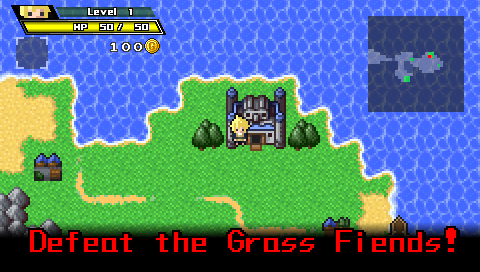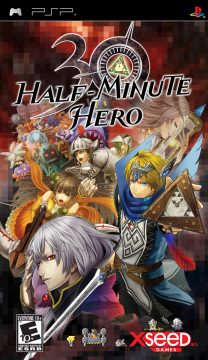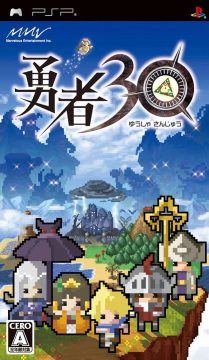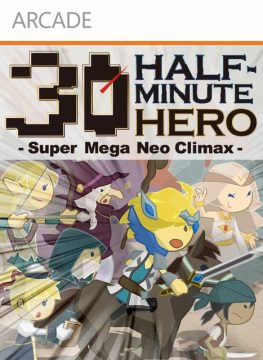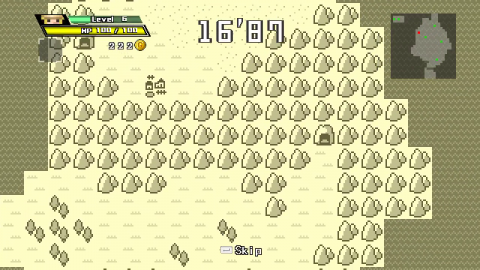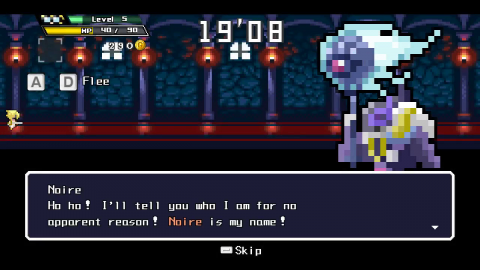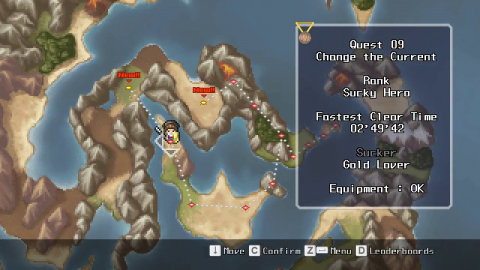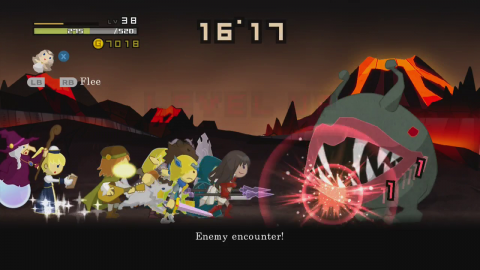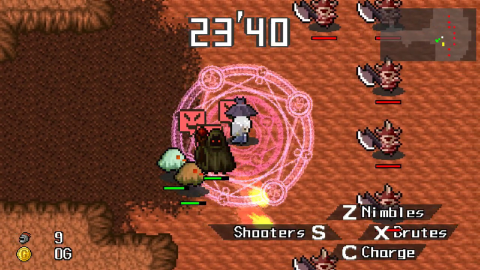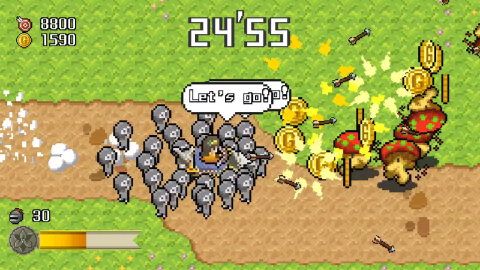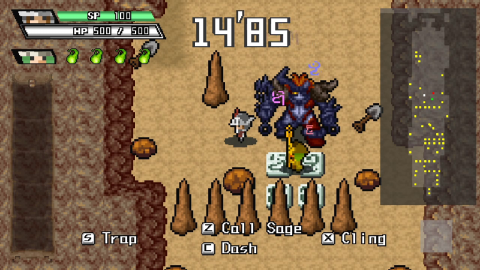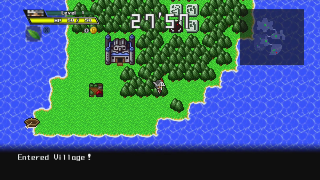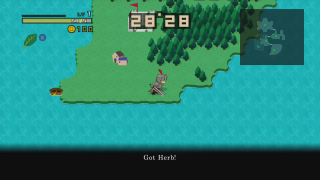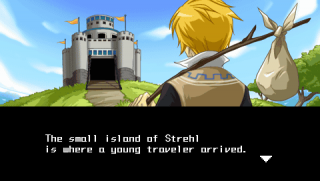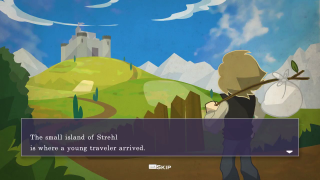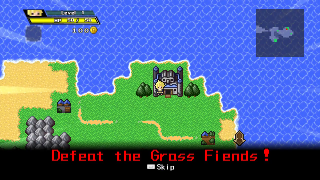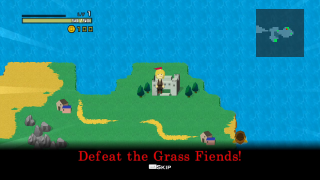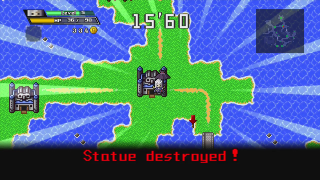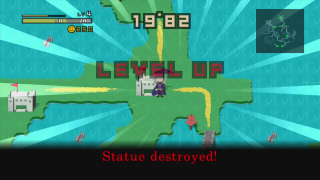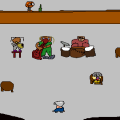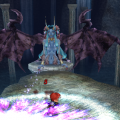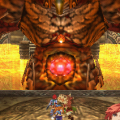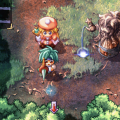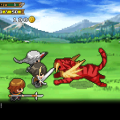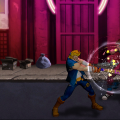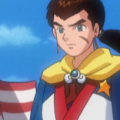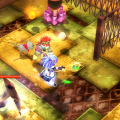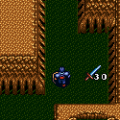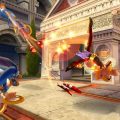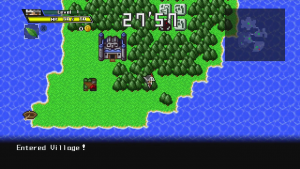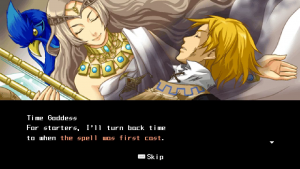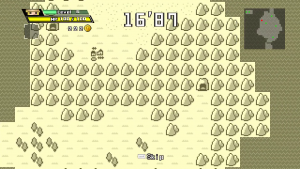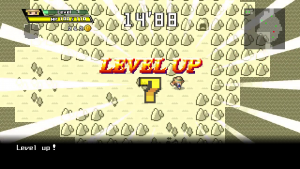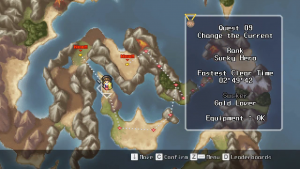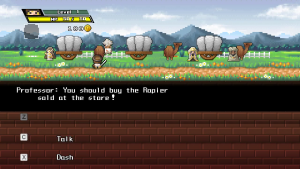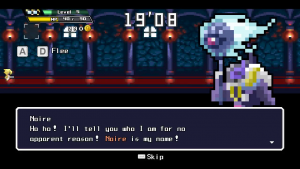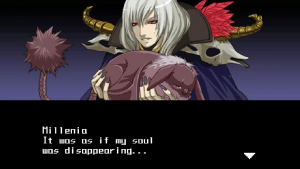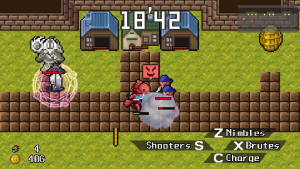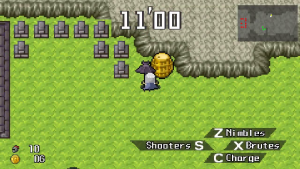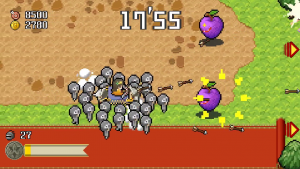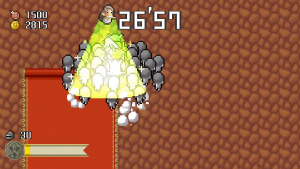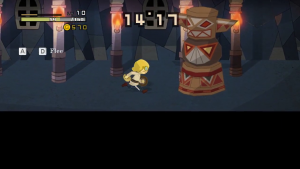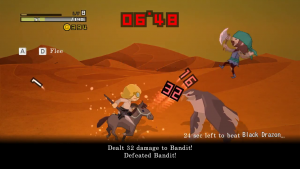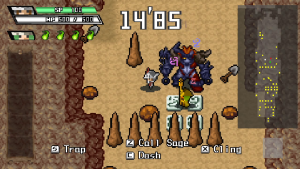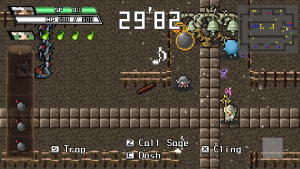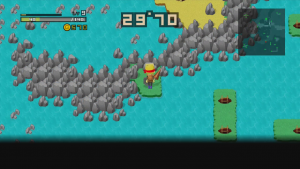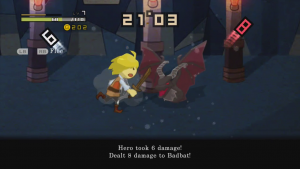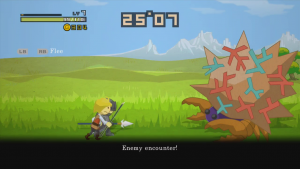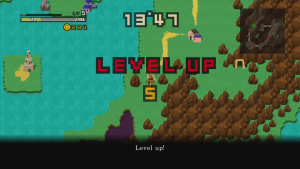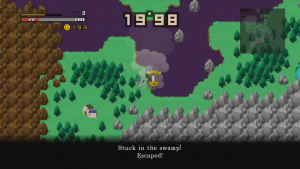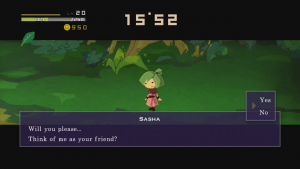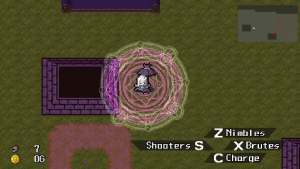- Half-Minute Hero
- Half-Minute Hero: The Second Coming
Half-Minute Hero by Marvelous Entertainment has one of the most tenacious and genre-savvy villains in the entire RPG genre. The demon in question, Noire, has created a spell to destroy the world in thirty seconds, but rather than cast it himself, he teaches it to a series of stooges for maximum redundancy and keeps on the run. And when even that fails, Noire comes back four times more, long after the previous heroes are dead, each time with a new plan and a new thirty-second timer. You have to admire the work ethic.
Half-Minute Hero is almost exactly what it sounds: it’s a stage-based RPG which ostensibly plays out in less time than it takes to boil an egg. In practice, the thirty-second timer is more of a marketing blurb. While it is possible to beat many of the game’s stages in under 30 seconds with the right speedrunning techniques, the real secret to your success is the Time Goddess, personification of both time and capitalism. If you fork over enough cash, she’ll restart the 30 second timer, but also up her rates. And so long as you can keep up with her rates, she’ll keep sending you back. Stop paying her, and she’ll let the world burn.
But that’s just the main game mode, “Hero 30.” Half-Minute Hero shipped with three other game modes, each with their own rules and 30-second timers, telling a continuous story. The game was later remade on XBLA and then PC, both very different versions with increasingly preposterous titles. In 2011, the game received a sequel based entirely on Hero 30, which was PSP exclusive in Japan, though was later brought to English PCs by Opus. Alongside their frantic gameplay, the games are enhanced by a huge range of celebrity guest composers alongside the house composer (eighteen guests in the original, twenty-four in the sequel!). These guests contribute only one or two tracks each, creating an eclectic, but always high-quality, OST.
Hero 30
Reading the description of the series above, it probably comes as no surprise that the original Half-Minute Hero was an open parody. As a result, the story is not all that important. It is Goddess Era Year 100, and it’s up to a generic traveller to save the world from unusually meticulous evil.
The structure Hero 30 mode is simple. The game is broken into stages, all mapped in such a way that they look like pieces of a larger, contiguous map. Each stage starts with opening titles and ends with end credits – the gag is that since most RPGs involve a bad guy destroying the world, each stage in Half-Minute Hero must be a “full” game in a (very) long-running RPG series.
You set to business at Level 1 and with 100 Gold. Your character can navigate the map at a walking pace or can hold Circle to Dash, which will cost you HP. Ships exist to cross the water, horses to run faster, and you can even fly with a dragon in some of the final stages, complete with artificial Mode 7 effects. Random encounters will pick at you in the wild at predictable intervals: these are critical for levelling up your character, but if you’re in a hurry they can be avoided by Dashing on the map.
Once you enter a fight, combat is conducted automatically, with the combatants smashing into one another and bouncing back like so many action figures. If the need presents, you can Dash in combat as well: this will hurry things along and keep knockback to a minimum. If you lose your health, the game will deposit you back at the start of the map.
Inside towns, the timer is frozen on Normal difficulty, though not on Hard. Towns feature the usual NPC gossip, alongside restaurants to refill your health, herb shops for portable healing, and equipment shops. The equipment is the real prize, since any equipment you buy will be carried over into later stages, though they cannot be brought back to earlier stages. Towns also play home to the Goddess Statues. To keep the thirty-second doomsday at bay, you must pay off the Time Goddess at these statues to restart the timer. The price starts low, but increase with each payment, making it harder and harder to keep going.
Your objective in almost every stage is to cross to the Evil Lord’s fortress and beat them before the timer runs out. You will have to level up to beat the boss, and the game will provide a flaming prompt saying “YOU > EVIL” after you reach a high enough level, although it is possible to beat the Evil Lord at a lower level with careful use of items and equipment. In most stages however, the true challenge is reaching the Evil Lord’s fortress in the first place. You’ll have to run side-quests to repair bridges, find holy grails, or locate mystical weapons like plastic fly swatters to overcome the Evil Lord’s special defences, all this while trying to find enough cash to buy the equipment and stay afloat in your debt to the Time Goddess. In some cases, resetting time will also reset certain progress, forcing you to do the bulk of the work inside of thirty seconds after all!
On top of the basic challenge, the game has a number of alternate objectives, like alternate stage paths that are unlocked by completing optional objectives. On top of this, the game keeps score. Your finishing time in each stage is ranked and each stage offers two achievement-style “Titles” available for doing tasks like completing a costly side quest or beating the boss without overcoming a critical obstacle. There is no reward for getting high scores or completing the Titles in the original Half-Minute Hero, though an achievement for each was added in the remakes.
Half-Minute Hero was re-released in 2011 on XBLA Half-Minute Hero: Super Mega Neo Climax, and on Steam in 2012 as Half-Minute Hero: Super Mega Neo Climax Ultimate Boy. The primary selling feature of the remakes is a complete art do-over using an interesting papercraft style, called “NEO Cartoon” mode, which the player can swap with the “Retro” graphics on the main menu. These remakes add a bevy of new stages, including an alternate finale arc, although they replace a certain stage from the original that was called “Another Goddess” which was an extended reference to Marvelous’ Valhalla Knights.
Hero 30 also features competitive multiplayer, with solo play allowed for practice. The PSP version launched with only three maps for multiplayer, but later revisions boosted this to ten.
While Hero 30 is the best of the four game types available in Half-Minute Hero, there are some general flaws that take it down a few pegs. For starters, the game never explains your stats, which are depicted as icons (the second-most popular Steam guide is spitefully named: “Stats: The Explanation You Should have Been Given!” by HeyItsKubur). In another icon issue, the PC version addresses player input via pictures of keyboard keys, even if you’re using a game pad, despite being built on the Xbox version.
Hero 30 also lacks a certain variety. Playing stage after stage of mini-RPG without interruption gets tiring. This is arguably why Hero 30 is just one of a four-game set. Unfortunately, the porting team for the XBLA removed the alternate game modes, replacing hours of gameplay with a single, extended Hero 30 stage for each campaign. Thankfully, the Steam version includes both the alternate modes and their XBLA replacement, though you access them through the unusual means of changing your graphics mode: Retro graphics gives you the full PSP campaigns, NEO graphics gives you the XBLA stubs.
Half-Minute Hero‘s alternate game modes are arguably whole games in their own rights, but their campaigns are brief. For this reason, they’ll be described in a more perfunctory manner than Hero 30.
Evil Lord 30
In Stage 10 of Hero 30, the hero spared a self-styled “Beautiful Evil Lord” who just wanted to live with his beloved. A century later, Noire returns, seizing the minds of the people with evil statues. The Beautiful Evil Lord takes over as protagonist, as he finds the statues so garish to stand.
Evil Lord 30 is an unusual real-time strategy game. All of it deliberately stiff: the Beautiful Evil Lord can barely speedwalk, forcing you to spend your 30 seconds as wisely as possible or be done in by your turtle-legs. It is possible to restore your timer by touching “Goddess Barrels” stocked about the arena, but they will cost you every penny you have on hand, money that would have otherwise gone towards upgrading your Max MP at the end of each map.
Evil Lord 30 works on a rock-paper-scissors model. The Beautiful Evil Lord is able to summon three types of monsters: Shooters, Brutes and Nimbles. Your enemies fall into the same categories. Shooters beat Brutes, Brutes beat Nimbles, and Nimbles beat Shooters. Damage is all but nullified if your troops hit the wrong target, so you must be exact with your resources. Too bad you have almost no control over your minions. You choose where to summon them, and can order them charge the enemy, but that’s it, and ordering your Shooters to bum-rush the enemy will do them no good whatsoever. The game also has terrible path-finding.
Funnily enough, you can’t actually die in Evil Lord 30, and only lose if you run out of time. That said, you do flinch from damage, and if you take hits, it will reduce your max MP until you reset time at a Goddess Barrel.
The XBLA version replaced Evil Lord 30 with an open-ended Hero 30 map representing the entire Evil Lord 30 campaign, giving the player plenty of optional approaches so long as they don’t run out the clock with their still-sluggish walking speed.
Princess 30
It’s now Goddess Year 300, and a king has brought peace to most of the world, so of course Noire poisons him. Unfortunately for Noire, the King had a “hyper-aggro” daughter, who will stop at nothing to revive her father – just so long as she gets home before her 30 second curfew.
Princess 30 is the simplest of the four games. The game is top-down shooter, vertical or horizontal depending on the stage, which gives you 30 seconds to get to the end of each micro-stage and back to the castle before your mother shuts the door. Being locked out leaves you with a disturbing Game Over screen of The Princess wailing at the castle gates as, presumably, monsters close in to devour her.
The Princess carts a heavy machine-crossbow, able to fire in all four directions with the face buttons. The longer you hold down the button, the narrower your stream of fire. Since the crossbow is so heavy, the princess must be carted on a palanquin by her horde of bodyguards. Each time you take a hit, you’ll lose guards until you’re down to your most loyal twosome, at which point hits will stop you from shooting. Each lost guard costs you speed and mobility, as well as medical bills at the end of the stage, but guards recover after a few seconds. Later stages include fairies that grant temporary power-ups.
Unlike most scrolling shooters, it’s possible to control how quickly the game scrolls by moving toward or away from the direction of travel. If you are running out of time, there are “Goddess Carpets” which will restore time the longer you stand on them, though a round of Princess 30 is still unlikely to last more than a minute. Princess 30 is fun, but brief.
Princess 30’s XBLA stage is unremarkable, a standard Hero 30 map.
Knight 30
Knight 30 represents an odd turn in Half-Minute Hero‘s story. While the game had previously handled drama with an infrequent hand, Knight 30 opens by announcing that the Time Goddess has been (comically) captured and (not so comically) murdered, leading to 100 years of apocalyptic darkness. We turn to two wanderers, out to arrange “a miracle.”
In Knight 30, you are no longer the dominant Hero running through monsters like newsprint: Now the monsters are winning, and you have to run away. Your only salvation is a dramatic reversal: your companion, the Sage, knows a spell to wipe out nearby monsters in 30 seconds. You just have to keep him alive long enough to cast it.
You can direct the Sage with Triangle, or take his hand with X to lead him directly, and can even Dash while holding his hand to hoist him over your head! Sage can only chant his spell while stationary, so you’ll have to find a safe place to hide, preferably on plots of holy ground that will double his casting rate. But you’ll never be able to stay still for long.
Knight’s only unarmed attack is slow and double-edged, so it’s better for him to locate objects in the environment to use them as breakable weapons. Monsters cannot be killed by Knight, only stunned, but once stunned the smaller ones can be picked up and thrown away, even serving as projectiles in their own right! Occasionally, you will also be confronted with “Bedlam Bells,” noisy contraptions that prevent the Sage from chanting so long as they are ringing. The Knight will have to destroy the bells or, in the case of indestructible golden bells, delay their operators by throwing them bodily from the area.
Unlike other modes, score matters in Knight 30, as it converts to EXP. Knight can also ration his nights by hour to recover stamina or construct traps. The traps range from distracting scarecrows, portable walls and damaging bombs. Because of the way trap production levels up, the system is unbalanced, making the end of the game exponentially easier than the start.
Knight 30’s XBLA replacement stage is a nail-biter, broken up into sub-stages that all have to be completed before their individual 30 second timers are up. With no Time Goddess, there’s no chance to reset!
After Knight 30, the game’s story wraps up in a massive map called “Hero 300,” followed by a challenge map, “Hero 3,” which are exactly what they claim. All-in-all, Half-Minute Hero does what it was supposed to do, though you can see where it tried to push at the seams of its “fit into your bus ride” structure. It would get the opportunity two years later in Japan, with the longer, more involved sequel.
While most of the game’s major version differences have been discussed above, the PSP original includes a CG opening that was left behind on the platform. This is also the only version to contain a constantly updating gallery feature – this feature does not appear at all on XBLA, and is only unlocked, already complete, after clearing “Hero 3” on PC.
Screenshot Comparisons
